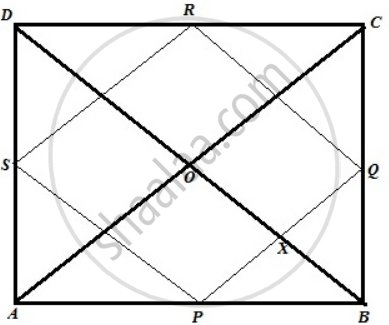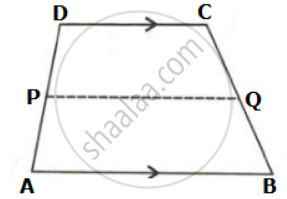Advertisements
Advertisements
प्रश्न
If the quadrilateral formed by joining the mid-points of the adjacent sides of quadrilateral ABCD is a rectangle,
show that the diagonals AC and BD intersect at the right angle.
उत्तर
The figure is shown below
Let ABCD be a quadrilateral where P, Q, R, S are the midpoint of AB, BC, CD, DA.PQRS is a rectangle. Diagonal AC and BD intersect at point O. We need to show that AC and BD intersect at a right angle.
Proof:
PQ || AC, therefore ∠AOD = ∠PXO ...[ Corresponding angle ]...(1)
Again BD || RQ, therefore ∠PXO = ∠RQX = 90° ....[ Corresponding angle and angle of a rectangle ]...(2)
From (1) and (2) we get ,
∠AOD = 90°
Similarly, ∠AOB = ∠BOC = ∠DOC = 90°
Therefore diagonals AC and BD intersect at right angle.
Hence proved.
APPEARS IN
संबंधित प्रश्न
In a ΔABC, E and F are the mid-points of AC and AB respectively. The altitude AP to BC
intersects FE at Q. Prove that AQ = QP.
In Fig. below, BE ⊥ AC. AD is any line from A to BC intersecting BE in H. P, Q and R are
respectively the mid-points of AH, AB and BC. Prove that ∠PQR = 90°.

ABCD is a kite having AB = AD and BC = CD. Prove that the figure formed by joining the
mid-points of the sides, in order, is a rectangle.
In triangle ABC, AD is the median and DE, drawn parallel to side BA, meets AC at point E.
Show that BE is also a median.
A parallelogram ABCD has P the mid-point of Dc and Q a point of Ac such that
CQ = `[1]/[4]`AC. PQ produced meets BC at R.

Prove that
(i)R is the midpoint of BC
(ii) PR = `[1]/[2]` DB
In the given figure, ABCD is a trapezium. P and Q are the midpoints of non-parallel side AD and BC respectively. Find: PQ, if AB = 12 cm and DC = 10 cm.
In ΔABC, P is the mid-point of BC. A line through P and parallel to CA meets AB at point Q, and a line through Q and parallel to BC meets median AP at point R. Prove that: AP = 2AR
AD is a median of side BC of ABC. E is the midpoint of AD. BE is joined and produced to meet AC at F. Prove that AF: AC = 1 : 3.
The figure obtained by joining the mid-points of the sides of a rhombus, taken in order, is ______.
In ∆ABC, AB = 5 cm, BC = 8 cm and CA = 7 cm. If D and E are respectively the mid-points of AB and BC, determine the length of DE.
